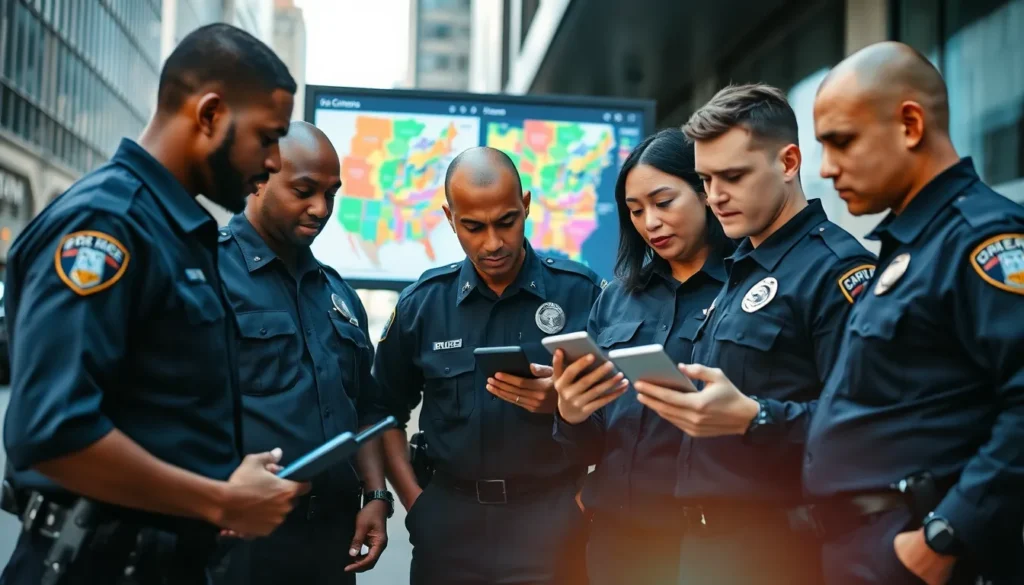Table of Contents
ToggleIn a world where every second counts, public safety analytics is the superhero we didn’t know we needed. Imagine a trusty sidekick that helps law enforcement agencies predict crime patterns, allocate resources, and keep communities safe—all while wearing a cape made of data. With the rise of technology, this powerful tool is transforming how cities tackle safety challenges, making it a game-changer for first responders and citizens alike.
But wait, there’s more! Public safety analytics doesn’t just crunch numbers; it tells a story. By analyzing trends and behaviors, it helps officials make informed decisions that can save lives. So, whether it’s preventing crime or responding to emergencies, this analytics powerhouse is here to ensure that safety isn’t just a priority—it’s a guarantee. Buckle up as we dive into the fascinating world of public safety analytics and discover how it’s reshaping our communities for the better.
Overview of Public Safety Analytics
Public safety analytics serves as an essential resource for law enforcement agencies. Utilizing data-driven techniques, this approach predicts crime trends and identifies problematic areas. Organizations employ a variety of data sources, including historical crime reports, social media activity, and community inputs.
Crime mapping tools highlight hotspots, helping police to allocate resources efficiently. With geographic information systems (GIS), agencies visualize crime patterns and community demographics. Predictive modeling techniques analyze past incidents to forecast potential future crimes, thus enhancing strategic planning.
Community engagement plays a key role in effective public safety analytics. Surveys and feedback mechanisms allow residents to report concerns and insights. Incorporating this community data improves the relevance of analytics and fosters trust between citizens and law enforcement.
Technology advancements continue to drive public safety analytics forward. Machine learning algorithms process vast datasets, uncovering hidden patterns that traditional methods may miss. Real-time data integration helps police respond more effectively to incidents, improving overall public safety outcomes.
Analytical dashboards consolidate key metrics, providing law enforcement leaders with actionable intelligence at a glance. These tools foster collaboration between various departments, ensuring a unified approach to public safety challenges.
Overall, public safety analytics offers a framework for informed decision-making. The use of comprehensive data not only transforms how police operate but also strengthens community safety initiatives.
Importance of Public Safety Analytics

Public safety analytics plays a vital role in modern law enforcement strategies. By leveraging data, agencies can enhance community safety and improve overall public service.
Enhancing Crime Prevention
Crime prevention becomes more effective through data analysis. Agencies use historical crime reports to identify trends, which helps them anticipate criminal activities. With predictive modeling, law enforcement can focus on high-risk areas, allowing for timely interventions. Social media data also provides insights into potential threats and emerging issues. Community feedback adds valuable context, ensuring approaches are aligned with residents’ needs. By integrating various data sources, analytics constructs a comprehensive picture of public safety, which is critical for proactive crime prevention.
Resource Allocation
Efficient resource allocation is essential for optimizing law enforcement operations. Analytics identifies crime hotspots through advanced mapping techniques, enabling targeted deployment of police resources. Strategic planning benefits from real-time data integration, which allows agencies to adapt to changing situations. Decision-makers gain access to analytical dashboards, which display key metrics, providing insights into where resources are most needed. This data-driven approach enhances communication between departments, fostering collaboration in addressing public safety challenges. Ultimately, analytics maximizes the effectiveness of law enforcement efforts, ensuring resources are allocated where they can make the biggest impact.
Key Components of Public Safety Analytics
Public safety analytics plays a vital role in enhancing law enforcement effectiveness. Key components include data collection methods and analysis techniques, both critical for informed decision-making.
Data Collection Methods
Numerous data sources contribute to public safety analytics. Historical crime reports offer insights into past incidents. Social media activity reflects community sentiment and emerging trends. Community inputs such as surveys and direct feedback also highlight local concerns. Law enforcement agencies compile these varied data points into a centralized database. Geographic information systems (GIS) visualize this data geographically, allowing easy identification of crime hotspots. Technology integration ensures data collection happens in real time, enhancing the accuracy of information gathered.
Analysis Techniques
Advanced techniques drive the analysis of collected data. Predictive modeling analyzes historical crime trends to forecast future incidents. Machine learning algorithms further refine these predictions by identifying patterns within large datasets. Statistical analysis helps determine correlations between various factors, including demographics and crime rates. Law enforcement can prioritize resource allocation based on analytical outcomes. Dashboards visualize key metrics, presenting actionable intelligence clearly and concisely. Enhanced collaboration among departments also results from shared analysis, leading to coordinated strategies for addressing public safety challenges.
Case Studies in Public Safety Analytics
Public safety analytics showcases a range of successful applications that strengthen community safety. These case studies illustrate the practical benefits of leveraging data in law enforcement strategies.
Successful Implementations
In various cities, public safety analytics has led to significant improvements. Los Angeles developed a predictive policing program that analyzed crime patterns, ultimately reducing gang-related violence by 30% within two years. Similarly, Chicago implemented real-time crime mapping, allowing the police to deploy resources more effectively, resulting in a 20% drop in property crimes. New York City utilized social media analytics to gauge community sentiment and identify crime hotspots. This approach facilitated targeted interventions that addressed both crime prevention and community engagement.
Lessons Learned
Implementations reveal valuable insights about public safety analytics. One key lesson involves the necessity of accurate data collection; unreliable data can misguide decision-making. Additionally, collaboration between departments has proven essential, fostering a unified approach to address crime. Engaging citizens in the analytics process enhances trust and provides valuable local insights. Regular updates to analytical models based on evolving crime patterns also contribute to more effective strategies. Overall, organizations must remain adaptable, ensuring algorithms stay relevant in a changing landscape.
Challenges in Public Safety Analytics
Public safety analytics faces several challenges that can impact its effectiveness. These challenges include issues of data privacy and the integration of new technology with existing systems.
Data Privacy Concerns
Data privacy remains a critical issue in public safety analytics. Collecting personal information raises concerns regarding citizens’ rights and trust in law enforcement. Balancing the need for data with privacy regulations, such as the General Data Protection Regulation (GDPR), poses significant challenges. Transparency in data collection processes is essential to mitigate fears of misuse. Building trust requires agencies to establish clear policies governing data usage and sharing. Engaging the community in discussions about data practices can enhance public confidence and promote collaboration.
Integration with Existing Systems
Integrating new analytics technology with existing systems presents notable difficulties. Compatibility between disparate software platforms often complicates data sharing and analysis. Law enforcement agencies face challenges in securing adequate training for personnel on new tools, resulting in resistance or underutilization. Legacy systems may lack the necessary infrastructure to support advanced analytics, impeding progress. Successful integration depends on effective change management strategies that encourage user adoption and system alignment across departments. Prioritizing a gradual rollout with continuous feedback can facilitate smoother transitions and maximize the benefits of public safety analytics.
Public safety analytics is reshaping the landscape of law enforcement. By leveraging data-driven insights and advanced technology, it empowers agencies to make informed decisions that enhance community safety. The integration of various data sources fosters collaboration between law enforcement and citizens, building trust and encouraging proactive crime prevention.
As cities continue to adopt these innovative strategies, the potential for improved public safety grows. The ongoing challenge of balancing data privacy with effective analytics remains critical. However, with transparent practices and community engagement, public safety analytics can lead to safer environments for all. The future of law enforcement lies in its ability to adapt and evolve through these analytical advancements.







